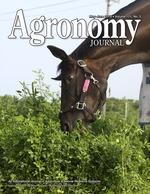Ver ítem
- xmlui.general.dspace_homeCentros Regionales y EEAsCentro Regional Santa FeEEA OliverosArtículos científicosxmlui.ArtifactBrowser.ItemViewer.trail
- Inicio
- Centros Regionales y EEAs
- Centro Regional Santa Fe
- EEA Oliveros
- Artículos científicos
- Ver ítem
Soybean nitrogen sources and demand during the seed-filling period
Resumen
Soybean [Glycine max (L.) Merr.] seed N demand not met by biological N fixation is fulfilled by N remobilization from vegetative plant organs and N uptake from soil sources during the seed-filling period (SFP), herein termed N gain. The objectives of this study were to: (i) quantify the contribution of plant organs to N remobilization during the SFP, (ii) determine the association between N gain and N remobilization, and (iii) study the effect of seed
[ver mas...]
Soybean [Glycine max (L.) Merr.] seed N demand not met by biological N fixation is fulfilled by N remobilization from vegetative plant organs and N uptake from soil sources during the seed-filling period (SFP), herein termed N gain. The objectives of this study were to: (i) quantify the contribution of plant organs to N remobilization during the SFP, (ii) determine the association between N gain and N remobilization, and (iii) study the effect of seed yield in both N gain and N remobilization processes. Three field experiments were conducted in 2015 and 2016 in Kansas. Three soybean genotypes: (i) non-Roundup Ready (RR), released in 1997; (ii) RR-1, released in 2009; and (iii) RR-2, released in 2014 were tested under three N rates: (i) control without N application (zero-N); (ii) 56 kg N ha–1 applied at R3 stage (late N); and (iii) 670 kg N ha–1 (full N; three applications of 223 kg N ha–1) applied at planting, R1, and R3 stages. The late-N and full-N rates increased yields by 9% (256 kg ha–1) relative to the zero N. Neither genotypes nor N rates affected N gain nor N remobilization. Nitrogen remobilization accounted for 59% of seed N demand at maturity, mainly driven by biomass at R5.5, with the leaf organ as the main contributor (52%) of the total remobilized N. Nitrogen remobilization was negatively related to N gain, and increases in N gain were linked to increases in biomass and yield.
[Cerrar]

Autor
Ortez, O.A.;
Tamagno, S.;
Salvagiotti, Fernando;
Prasad, P.V.V.;
Ciampitti, Ignacio A.;
Fuente
Agronomy Journal Disponible mayo 2019
Fecha
2019-05
Editorial
American Society of Agronomy
ISSN
0002-1962
1435-0645
1435-0645
Formato
pdf
Tipo de documento
artículo
Palabras Claves
Derechos de acceso
Restringido
 Excepto donde se diga explicitamente, este item se publica bajo la siguiente descripción: Creative Commons Attribution-NonCommercial-ShareAlike 2.5 Unported (CC BY-NC-SA 2.5)
Excepto donde se diga explicitamente, este item se publica bajo la siguiente descripción: Creative Commons Attribution-NonCommercial-ShareAlike 2.5 Unported (CC BY-NC-SA 2.5)

